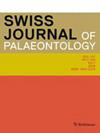龟总目早期化石记录:生物地理意义
IF 3
2区 地球科学
Q1 PALEONTOLOGY
引用次数: 0
摘要
caturo总纲是中生代主要生活在侏罗纪的掠食性鳍鱼的一个分支。该分支在白垩纪早期有一些记录,而在三叠纪只有两个记录。在后者中,标本MPCA 632 Caturus sp.可能来自早三叠世的阿根廷大陆,即欧洲以外,根据该群体已知的化石记录,它们的起源表明它们来自西特提斯,这尤其有问题。对MPCA 632的块状岩石样品进行了微古生物学和地球化学分析,使我们能够纠正标本的来源,该标本对应于阿根廷neuqusamen Vaca Muerta组的泰通世海相露头。MPCA 632可能是Vaca Muerta组(Los Catutos成员)已知的唯一Catutoichthys olsacheri的标本,但化石没有可比性,因此这一假设需要进一步研究。此外,对奥地利塞菲尔德(Seefeld)诺里亚地区唯一的另一种三叠纪龟类(Furo insignis)的模式材料的第一手研究,导致该分类群被排除在龟类总科之外。因此,龟总枝被限制在侏罗纪-晚白垩纪。经过早侏罗世的适度演化,中侏罗世开始向西辐射并向西扩散,在基默里吉纪和梯东纪达到了最大的多样性。本文章由计算机程序翻译,如有差异,请以英文原文为准。
The early fossil record of Caturoidea (Halecomorphi: Amiiformes): biogeographic implications
Caturoidea is a clade of Mesozoic predatory ray-finned fishes which lived mainly in the Jurassic. The clade has a few records in the earliest Cretaceous and only two in the Triassic. Among the latter, specimen MPCA 632 Caturus sp. doubtfully from continental Early Triassic of Argentina, i.e., outside Europe, was particularly problematic in the light of the known fossil record of the group, which suggested their origin in the Western Tethys. The micropaleontological and geochemical analysis of bulk-rock samples of MPCA 632 allowed us to correct the provenance of the specimen which corresponds to Tithonian marine outcrops of the Vaca Muerta Formation, Neuquén, Argentina. Specimen MPCA 632 is excluded from Caturus and reclassified as Caturoidea sp. MPCA 632 might be a specimen of Catutoichthys olsacheri, the only caturoid known from the Vaca Muerta Formation (Los Catutos Member), but the fossils are not comparable and, thus, this hypothesis needs further study. Additionally, the first-hand study of the type material of the only other alleged Triassic caturoid, Furo insignis, in the Norian of Seefeld, Austria, led to the exclusion of this taxon from the Caturoidea. Consequently, the clade Caturoidea is restricted to the Jurassic–Lowest Cretaceous. After a modest evolution during the Early Jurassic, the group had its initial radiation and westward dispersion across the Hispanic Corridor during the Middle Jurassic and reached its maximal diversity during the Kimmeridgian and Tithonian.
求助全文
通过发布文献求助,成功后即可免费获取论文全文。
去求助
来源期刊

Swiss Journal of Palaeontology
Earth and Planetary Sciences-Paleontology
CiteScore
4.30
自引率
16.70%
发文量
17
审稿时长
4 weeks
期刊介绍:
The Swiss Journal of Palaeontology publishes original research and review articles of interest to the international community in the fields of palaeontology, taxonomy and systematics, while recognising at the same time the importance of documenting high-quality palaeontological data in a regional context. Palaeobiology in combination with alpha taxonomy is a core topic of the journal.
Submitted papers should have an appeal as wide as possible, directed towards an international readership. Contributions should not have been simultaneously submitted elsewhere, and the overlap of content between related articles should be minimal. Duplications of text and the use of previously published illustrations without adequate citation are unacceptable. If a manuscript has two or more authors, both or all have to sign to confirm they all were involved in the work and have agreed to its submission. The preferred manuscript language is UK English, but consistently used US English is also acceptable. We encourage the publication of proceedings of international meetings as well as special thematic issues. Short contributions and book reviews are also accepted.
An international editorial team as well as guest editors guarantee that the thematic issues as well as all articles in regular issues are peer-reviewed and meet the highest standards.
 求助内容:
求助内容: 应助结果提醒方式:
应助结果提醒方式:


